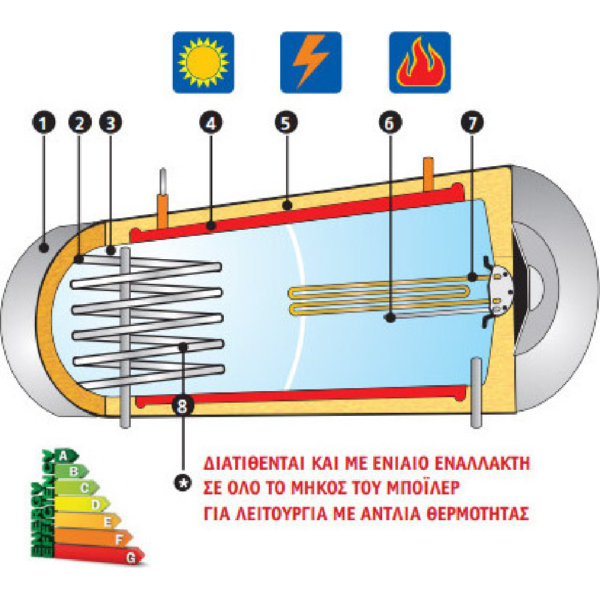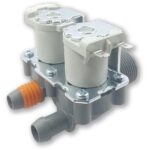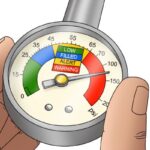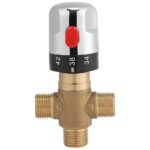Connecting the solar system to the central heating radiator system
The use of a triple energy solar water heater offers the possibility of utilizing alternative energy sources for hot water production. One of the most practical options is connecting the solar system to the central heating radiator system. This solution enhances the solar system’s performance on days with low sunshine or during the winter months, utilizing the energy from the boiler or heat pump to heat the water in the solar boiler.

How Does a Triple Energy Solar Water Heater Work?
A triple energy solar water heater operates with three different heat sources:
- Solar energy: The collectors absorb solar radiation and convert it into heat.
- Electric resistance ( heating element ): Activated in cases of low sunshine, providing an alternative heat source.
- Central heating: The solar system can be connected to the radiator boiler, so that hot water from the boiler heats the solar boiler.
Benefits of Connection with Radiators
Connecting the solar water heater with radiators provides multiple advantages:
- Stable hot water supply even on days when the sun is insufficient.
- Increased energy efficiency, as the boiler’s heating is fully utilized.
- Reduced use of electric resistance, limiting electricity consumption.
- Ease of use with automatic switching between heat sources.
Technical Specifications and Installation
Connecting the solar water heater to radiators requires careful planning and installation by a specialized technician. The basic parameters are described below:
1. Heat Exchanger in the Boiler
- The triple energy solar boiler must have a second heat exchanger (serpentine) specifically for central heating.
- The exchanger allows hot water from the radiator to heat the domestic hot water without mixing the two circuits.
2. Plumbing Connection
- Hot water from the boiler or heat pump is channeled through pipes to the solar heat exchanger.
- Flow is controlled by valves and thermostats, which regulate when hot water will be channeled to the boiler.
3. Automatic Source Switching
- An electronic control system ensures that the system will select the most economical energy source (e.g., sun, radiator, or electric resistance) depending on conditions.
- Priority is given to using solar energy, while heating from radiators is activated only when necessary.
4. Insulation and Safety
- It’s important to use pipes with high insulation to avoid heat losses.
- Protective valves and temperature sensors ensure proper operation and prevent overheating.
Application Cases
- Single-family homes with oil or natural gas boilers: Suitable for homes where the boiler operates on a daily basis.
- Houses with heat pumps: Ideal solution for low-temperature heating systems.
- Apartment buildings with shared heating: The solar system can be heated during hours when the boiler is active.
Cost and Performance
Estimated Cost
- A 160-liter triple energy solar system with a second heat exchanger costs approximately 800-1,000 euros, which is slightly more than a dual energy solar water heater. If someone has a central heating system, it’s good to purchase a triple energy solar system even if they don’t plan to connect it to radiators immediately, because replacing the solar system later for this reason requires purchasing materials (at least a boiler) as well as labor and connection materials.
- The cost of connection to radiators ranges from 200-300 euros for materials and labor. The cost is indicative; you must definitely contact a specialist installer because each case is different with different difficulties.
Overall Energy Savings
- With proper adjustment, heating from radiators can reduce the use of electric resistance by 50-70% during winter months.
Increased Consumption of the Central System
One point that must be taken into account is the potential increase in energy consumption from the central heating system. When radiators are used to heat water in the solar boiler, additional energy is required to cover the thermal needs of the heat exchanger. This additional consumption can increase oil or natural gas combustion in the boiler, especially if the heating system is not modern or well-adjusted. To limit this consumption, it’s important to have proper thermal insulation in the pipes and to use the system mainly when necessary, such as on days with minimal sunshine. Additionally, using a modern high-efficiency boiler or heat pump can significantly reduce operating costs.
Conclusion
Connecting a triple energy solar water heater to radiators is an efficient and practical solution for maintaining hot water all year round. Although it requires initial installation costs, the long-term energy and money savings make it an excellent investment for every household.
- Improvements in the Placement of the Data Logger - 29 January 2025
- Solar Water Heater Statistics – December 2024 - 10 January 2025
- Washing machines with dual water supply - 24 December 2024












